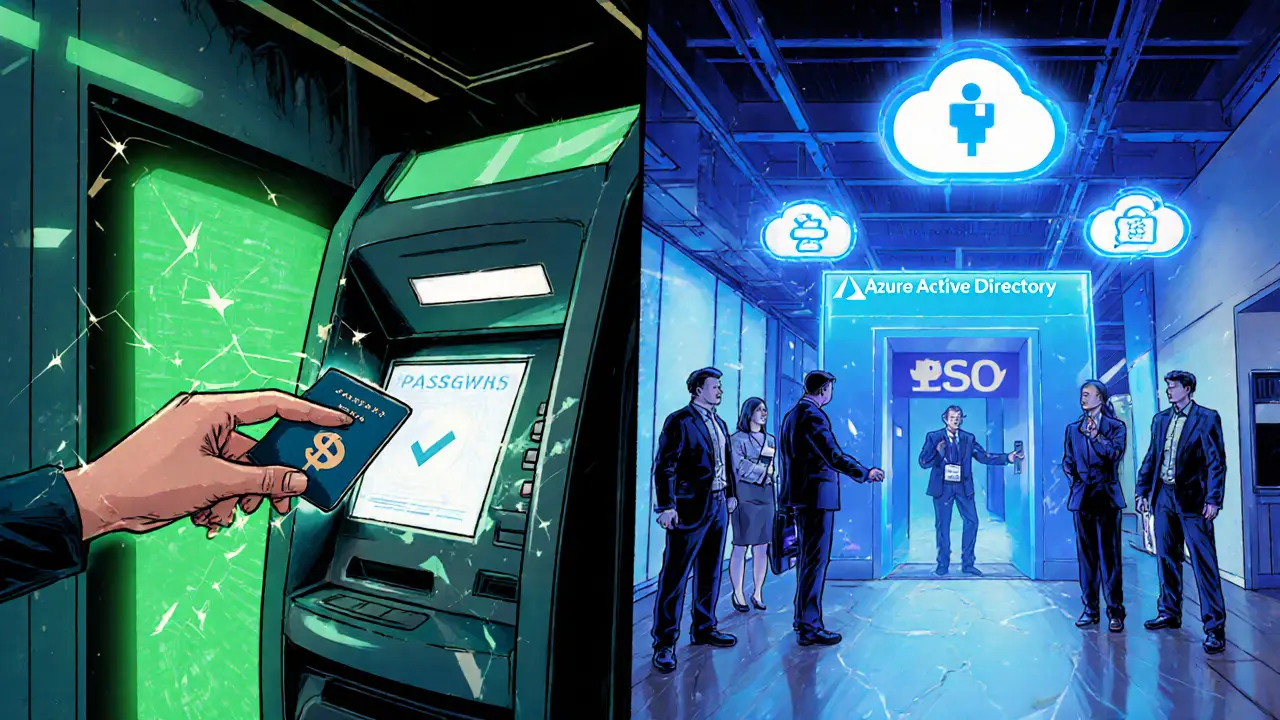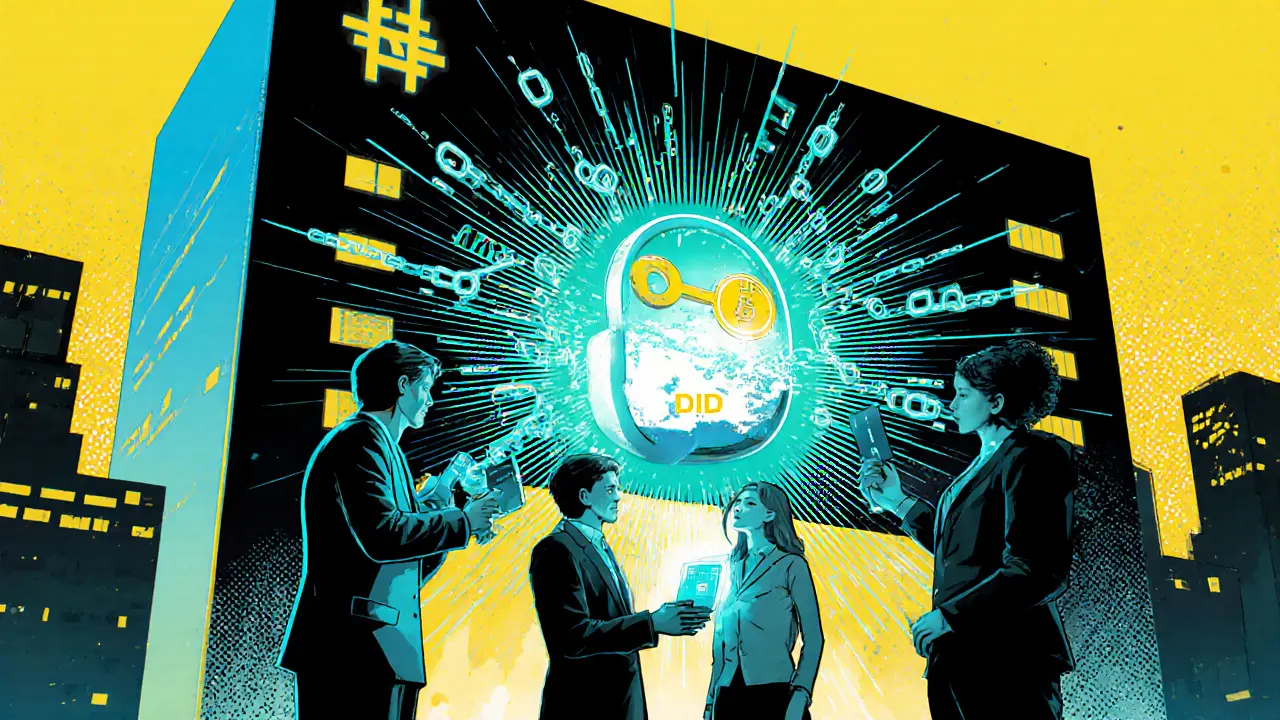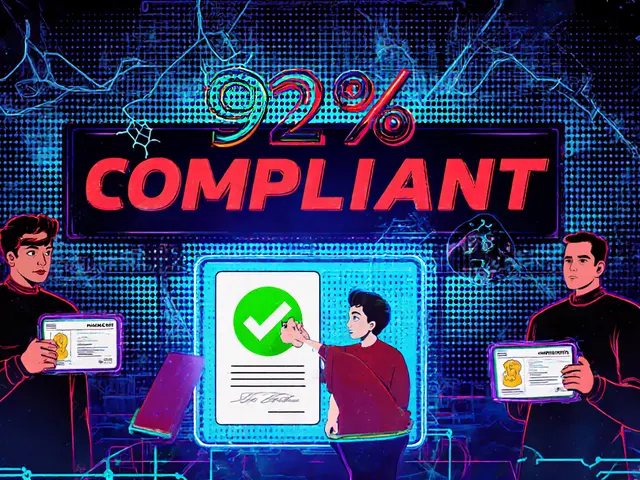DID vs Traditional Identity: Feature Comparison Tool
Compare key features of Decentralized Identity (DID) and traditional identity systems side-by-side.
User-controlled Blockchain-based Cryptographic verification
Your identity is stored in your digital wallet and verified through cryptographic proofs.
Organization-controlled Centralized database Standard protocols
Identity information is stored in centralized systems managed by organizations.
| Feature | DID | Traditional IAM |
|---|---|---|
| Data Storage | User-held in digital wallet | Central database owned by provider |
| Control | Full user control, selective disclosure | Provider control, limited user rights |
| Trust Anchor | Issuer + cryptographic proof | Single authority (organization) |
| Revocation | Real-time revocation via ledger | Database flag or password reset |
| Offline Support | Possible with local wallet verification | Typically requires online lookup |
| Implementation Effort | Higher – blockchain + wallet integration | Lower – existing IAM suites |
| Typical Use Cases | Travel visas, government IDs, fintech KYC | Enterprise SSO, education portals, corporate VPN |
Key Takeaways
- Security: DID eliminates single points of failure by distributing credentials
- Privacy: Users maintain control over their data with selective disclosure
- Trust Model: DID distributes trust among issuers and cryptographic proofs
- Adoption: Traditional systems are easier to implement but less secure
When you log into a website, you rarely think about who actually holds your personal data. That hidden decision-whether a central authority stores your credentials or you keep them in your own pocket-defines the split between Decentralized Identity and traditional identity solutions. Below we break down what each model does, why it matters, and how to choose the right approach for your organization.
What is Decentralized Identity (DID)?
DID is a digital identifier that is created, owned, and managed by the individual rather than a central provider. DIDs live on a distributed ledger-usually a blockchain-and point to cryptographic material stored in a digital wallet. When a service needs to verify you, it asks your wallet to present a verifiable credential signed by a trusted issuer. The whole exchange happens without any third‑party database holding your data.
How Traditional Identity Systems Work
In a classic setup, an organization runs an Identity and Access Management (IAM) platform. Users create accounts with usernames, passwords, and possibly multi‑factor tokens. All attributes-date of birth, SSN, email-are stored in centralized databases that the IAM queries each time you log in. Protocols like OAuth, OpenID Connect (OIDC), and SAML enable single sign‑on (SSO) across multiple apps, but the trust anchor remains the organization that owns the data store.

Core Differences Across Key Dimensions
Security architecture: Centralized systems create a single point of failure-if the database is breached, attackers can harvest millions of records. Decentralized models eliminate that hotspot because credentials never sit in one place; they are verified with cryptographic proofs anchored on a blockchain.
Privacy and user control: Traditional IAM gives users little say over how their data is reused. DIDs let individuals practice selective disclosure-sharing only the exact attribute a service asks for, and revoking it anytime.
Trust model: In the old world, you trust the organization that runs the IAM. With DIDs, trust is distributed; you trust the issuer of a credential and the cryptographic math that proves its validity.
Operational experience: Centralized solutions are quick to roll out because the tooling is mature. Decentralized solutions need blockchain nodes, wallet apps, and user education, which can raise the bar for initial adoption.
Offline verification: Because a verifiable credential is signed and stored locally, a wallet can prove identity without an internet connection, as long as the verifier has the public keys. Traditional IAM typically requires a live lookup to the central directory.
Side‑by‑Side Comparison
| Aspect | DID (Decentralized) | Traditional IAM |
|---|---|---|
| Data storage | User‑held in digital wallet | Central database owned by provider |
| Control | Full user control, selective disclosure | Provider control, limited user rights |
| Trust anchor | Issuer + cryptographic proof | Single authority (organization) |
| Revocation | Real‑time revocation via ledger | Database flag or password reset |
| Offline support | Possible with local wallet verification | Typically requires online lookup |
| Implementation effort | Higher - blockchain + wallet integration | Lower - existing IAM suites |
| Typical use cases | Travel visas, government IDs, fintech KYC | Enterprise SSO, education portals, corporate VPN |
Real‑World Examples
In the finance sector, a European bank piloted a DID‑based KYC flow where customers scanned their passport, received a verifiable credential, and later proved their identity at ATMs without touching the bank’s servers. This reduced the attack surface dramatically.
Conversely, a multinational corporation uses Azure Active Directory for SSO across 10,000 internal apps. Employees enjoy seamless login, but if Azure experiences an outage, every service stalls because the central directory is unavailable.
Governments are also experimenting. The city of Zug in Switzerland issued resident DIDs linked to a blockchain, allowing citizens to vote online with cryptographic assurance that each vote came from an eligible voter.

Implementation Considerations
If you’re leaning toward a DID solution, start with these steps:
- Choose a blockchain platform that supports DID methods (e.g., EthereumEIP‑736, Hyperledger Indy).
- Partner with a trusted credential issuer-banks, universities, or government agencies.
- Deploy a digital‑wallet SDK for iOS/Android so users can store and present credentials.
- Integrate a verifier component into your service that can read the credential, check the signature against the issuer’s public key on the ledger, and respect revocation status.
For traditional IAM, the checklist looks familiar:
- Provision a directory service (Active Directory, LDAP).
- Implement SSO protocols (OAuth, OIDC, SAML).
- Enforce MFA and regular password policies.
- Set up backup, disaster‑recovery, and audit logging.
Both paths require staff training, but DID adds a user‑education layer about managing private keys and wallets.
Future Outlook and Possible Convergence
Traditional IAM vendors are already adding privacy‑by‑design features-such as selective attribute release in OIDC-to narrow the gap. At the same time, DID frameworks are tackling usability hurdles, like seamless key recovery and enterprise‑grade wallet management.
In the next few years we may see hybrid models: an organization keeps a central directory for internal employees while accepting DID‑based credentials from external partners. This approach lets you reap the security benefits of decentralization without discarding existing investments.
Frequently Asked Questions
Can I use a DID for everyday logins like Google or Facebook?
Yes, several pilots integrate DIDs with OpenID Connect so you can sign in with a wallet instead of a password. Adoption is still early, but the standard is maturing quickly.
What happens if I lose my digital wallet?
Most wallet solutions offer a recovery phrase (12‑24 words) that you must store safely. Lose the phrase, and the credentials are unrecoverable-just like losing a private key.
Are DIDs compliant with GDPR?
Because users control their data, DIDs can simplify data‑subject rights. The holder can delete or revoke credentials, which satisfies the “right to be forgotten” in many scenarios.
Do DIDs require a blockchain for every transaction?
Only the creation and revocation of DIDs need to be recorded on a ledger. The actual credential exchange happens off‑chain, keeping performance high.
How does cost compare between the two approaches?
Traditional IAM often incurs licensing fees and infrastructure costs that are predictable. DID projects may have lower ongoing fees but require upfront investment in blockchain nodes and wallet development.



mark noopa
October 10, 2025 AT 09:05When you stare at the sleek table of features in that post, you realize that the debate between DID and traditional IAM is not just technical, it's a metaphysical clash of control versus convenience 😎.
On one hand, you have the ancient oracle of centralized directories, forever guarding the gates of data like a tired librarian who never sleeps.
On the other, the rebellious teenager of the internet, the decentralized identity, shouting "I own my data!" from the rooftops of blockchain.
But the truth lies somewhere in the twilight zone between these extremes, where user experience meets security poetry.
Consider the user‑held wallet: it feels like carrying a physical passport in your phone, yet the cryptographic proofs are as invisible as the wind.
That wind can blow away your keys if you lose the recovery phrase, a risk no central admin can patch.
Meanwhile, traditional IAM offers the comforting blanket of password resets and help desks, but that blanket is riddled with holes that hackers love to poke.
Every time you reset a password you’re basically handing the attacker a fresh ticket to the party.
Decentralized revocation via ledger is like having a self‑destruct button on your credentials, instantaneous and immutable.
Centralized revocation, however, lags behind, waiting for a manual flag that might never be set in time.
Offline verification in DID is a game‑changer: imagine proving who you are in a remote mountain cabin with no internet, just a QR code and a smile.
Traditional systems will leave you stranded, staring at a “cannot connect” error while the snow falls outside.
Implementation effort is indeed higher for DIDs; you need nodes, wallets, and user education, which sounds like a nightmare for an IT budget committee.
Yet the payoff is a reduction in single points of failure, which could prevent the next massive breach that makes headlines.
The hybrid future might be the sweet spot, letting enterprises keep their legacy SSO while accepting verifiable credentials from partners.
In the end, the choice boils down to risk tolerance, user base sophistication, and whether you want to be a pioneer or a cautious commuter on the tech highway. 🚀
Rama Julianto
October 10, 2025 AT 11:52Listen, the post glosses over the fact that DIDs still suffer from massive UX hell – users lose keys and you get a support nightmare!
Traditional IAM may be boring but at least you can call support and get a password reset.
If you think people will actually manage crypto wallets daily, you’re dreaming.
Helen Fitzgerald
October 10, 2025 AT 16:02Hey folks, great breakdown! I love how the author highlighted selective disclosure – that’s a game‑changer for privacy‑first apps.
From my experience rolling out a DID‑based KYC, the biggest win was cutting down on data redundancy.
Just remember to train your users on wallet recovery, otherwise you’ll see a spike in support tickets.
Also, don’t forget to keep an eye on the ledger costs; they can add up fast.
Overall, the hybrid approach seems the most pragmatic for most orgs right now.
Jon Asher
October 10, 2025 AT 19:22Got it, the control shift is huge.
But we still need simple UX for the average joe.
Scott Hall
October 10, 2025 AT 22:59Cool comparison, especially the part about offline verification – that could be a lifesaver in remote deployments.
I’ve seen teams struggle with traditional IAM when the network goes down, and everything freezes.
DIDs could keep critical services humming even when the ISP is out.
Just make sure your wallet app works offline and caches the needed public keys.
Jade Hibbert
October 11, 2025 AT 01:29Sure, if you love losing your private key, go for it.
Otherwise, stick with passwords you can actually remember.
Leynda Jeane Erwin
October 11, 2025 AT 03:42While the enthusiasm for DIDs is refreshing, we must also consider regulatory compliance.
Many jurisdictions still require a centralized audit trail, which DIDs alone don’t provide.
Hybrid models can bridge that gap by logging verification events on a private ledger.
Brandon Salemi
October 11, 2025 AT 05:39Decentralized identity is the future, period.
Siddharth Murugesan
October 11, 2025 AT 07:52Honestly, the hype around blockchain for identity is overblown.
Most enterprises can't afford the extra latency and operational overhead.
If you want solid security, tighten your IAM policies instead.
Hanna Regehr
October 11, 2025 AT 09:32Valid point about latency.
In my recent pilot, we mitigated it by using a side‑chain for credential revocation, which kept response times low.
Also, layering rate‑limiting helped protect against abuse.
Ben Parker
October 11, 2025 AT 12:52Nice table! 👍👍
Can’t wait to see more real‑world DID use cases.
Daron Stenvold
October 11, 2025 AT 17:02From a formal standpoint, the security architecture of DIDs presents a paradigm shift that necessitates rigorous cryptographic audits.
Each verifiable credential must be examined for signature integrity, and issuers should be accredited by recognized authorities.
The delegation model eliminates the singular point of failure inherent in monolithic IAM solutions, thereby reducing systemic risk.
However, the operational complexity introduced by blockchain consensus mechanisms cannot be ignored; latency and throughput are critical metrics that must meet enterprise SLAs.
Compliance frameworks such as ISO/IEC 27001 still require evidence of data handling controls, which can be satisfied through immutable ledger entries.
In practice, a hybrid deployment-retaining centralized directory services for internal users while accepting external DIDs for partners-offers a balanced risk profile.
Such an architecture allows organizations to leverage existing SSO infrastructure while gradually onboarding decentralized identifiers where appropriate.
Additionally, key recovery mechanisms must be instituted to address the inevitable loss of wallet credentials, perhaps via social recovery or multi‑party escrow.
Governance policies must also define revocation procedures on-chain to ensure timely propagation of credential invalidation.
Ultimately, the strategic decision hinges on the organization’s appetite for innovation versus the necessity for proven stability.
hrishchika Kumar
October 11, 2025 AT 19:15🌍 Adding a cultural lens, many communities already practice forms of decentralized identity through lineage records and local attestations.
Integrating these indigenous trust models with modern DIDs could enrich the ecosystem and foster inclusivity.
Let’s not forget the power of diverse vocabularies in shaping user adoption.
Nina Hall
October 11, 2025 AT 22:19Optimistic vibes! The future looks bright for identity tech.
Excited to see more startups building user‑friendly wallet UX.
Keep the innovative spirit alive!
Lena Vega
October 11, 2025 AT 23:42Both models have trade‑offs.
Mureil Stueber
October 12, 2025 AT 02:12Interesting point about auditability.
Minimalistic approach keeps the discussion focused.
Emily Kondrk
October 12, 2025 AT 04:59They don’t tell you how the hidden miners manipulate the DID ledger to siphon data.
It’s a clandestine operation masked as security.
Stay woke.
Laura Myers
October 12, 2025 AT 08:35Whoa, this thread just turned into a techno‑drama!
I love the vibe – it feels like a sci‑fi saga where identities are the new super‑powers.
Can’t wait for the next episode where DIDs finally save the day.
Meanwhile, let’s keep the discussion grounded and practical.
Leo McCloskey
October 12, 2025 AT 11:55Indeed, while the narrative is compelling, one must not overlook the pragmatic constraints: scalability, cost-effectiveness, and interoperability.
The industry requires rigorous standards and empirical validation before universal adoption.